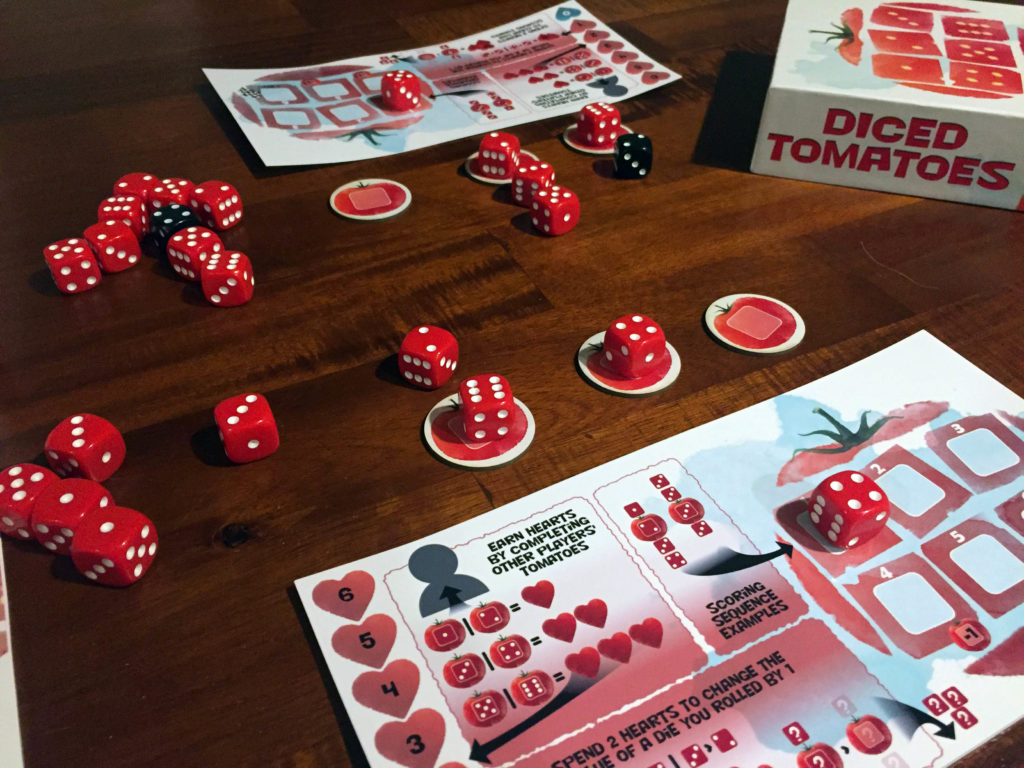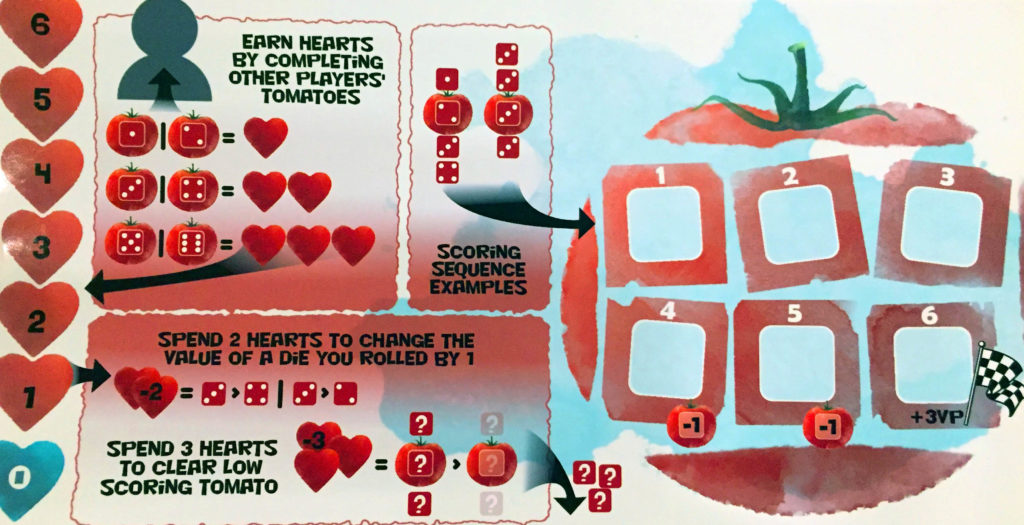I’m Italian, so tomato sauce is kind of in my blood. Since I’m not full on Italian, I bleed “Ragu” sauce instead of the homemade kind…but it’s a disability that I don’t mind living with. “Diced Tomatoes”, a 2-4 player game that is currently available for purchase on The Game Crafter for $29.99, promises a good time without the annoying acid reflux that normally comes with tomato sauce. Special thanks to Game Designer Arkadiusz Greniuk for sending a prototype for preview purposes. I’m told that the prototype I received should be of the same quality as what a customer would get if buying from The Game Crafter. Prototypes are not often reflective of the final product however, so everything that you’re about to see (including the rules) are subject to change. Per FCC Regulations I am required to note that this article was sponsored, however the opinions shared here are my own.

My prototype came with 44 red dice, 4 black dice, 12 tomato tokens, 4 red heart tokens, 4 player mats, and a rulebook. To set up the game, give each player 3 tomato tokens, 11 red dice, 1 black die, and a heart token (which goes on the heart 1 of the heart track). Each player keeps 3 of their tomatoes in front of them. One tomato token belonging to each player is locked down by flipping it over. It is flipped and made usable at the beginning of the second round. The first player is determined via a die roll, highest goes first.
The idea of “Diced Tomatoes” is to score points by…well, dicing tomatoes. Players will have three empty tomato tokens in front of them at the start of the game (one will be locked down until round two) and from there, will be rolling dice and assigning them to ANY of the player’s tomato tokens. If a token already has a die on it, you can add it to the “vine”…a vine being a column of dice. When there are four dice in a vine, it scores the value listed on the die situated on the token itself (not the other three above or below it). Rotten (black dice) cannot be placed onto a tomato but can be placed on a vine.
When a player dices someone else’s tomato by completing their vine, they earn gratitude and move their heart token up the track. Helping another player score a 1 or 2 earns 1 heart, whereas a 5 or 6 earns 3 hearts. Gratitude can be used to change the value of a rolled die or to remove all dice from one of your vines.

With the above in mind, the turn order is as follows:
1. Trade hearts to clear one of your tomatoes (optional).
2. Roll 3 dice (or less if it’s all you have) from your bushel (pool of dice).
3. Spend hearts to change dice values by 1 point up or down (optional).
4. Place individual dice onto tomatoes or vines belonging to any player. Any dice that aren’t placed go to the next player.
5. All players collect diced tomatoes from their play area and move the die on the tomato token to their player mat/score track. Move the three dice that did not score into that player’s bushel. You begin removing your tomato tokens after the fourth and fifth score. Finishing your sixth ends the game.
6. End your turn.
The game ends when a player dices the last tomato of any player or if a player starts their turn with no dice to roll. Players add up the dice on their diced/scored tomato tokens and subtract points per rotten die in their possession. The player with the highest score wins the game!
Editor’s Note: The above doesn’t go over every single rule found in the rulebook but should give you an idea as to how the game is played.
“Diced Tomatoes” is charming and full of theme. Choosing red and black dice to convey the tomatoes was a good move and I liked the idea of tomato tokens and the vines that result from them. Dice games tend to be fairly luck based but I am glad to see that players have a few options available to them when rolling poorly. For example, they can add low valued dice to their opponent’s tomato tokens so that they score less. Values on the vines don’t seem to matter and it would have been neat if there was an advanced variation that took those values into consideration somehow. I’m just spit-balling here, but what if the dice on the vine have to be equal to or greater than the dice on the tomato token? You’d want to test that for balancing purposes, obviously.
The average play time is around 15-30 minutes, making this a game that you can easily bring out during a busy weekday night after homework is finished and all that jazz. The strategy element is light too and while the box indicates that the appropriate age is 12+, I don’t see why gifted children of a younger age couldn’t play. Kids who are still putting things in their mouths would obviously be a no-go, what with the small pieces. As light as the gameplay is, there’s still a “take-that” element in that you can assign low valued red dice to other players’ tomatoes and/or rotten dice to other players’ vines. This could cause some resentment, especially if kids start ganging up on any one person. With this in mind, parental supervision would be recommended.
“Diced Tomatoes” is a light-hearted dice game that is easy to recommend. My only concern is the $30 price tag on The Game Crafter…which is way too high for a game like this, especially since I found the prototype components to be small, flimsy, and sub-par. I’ve dealt with games on The Game Crafter for a long time so I know WHY it has to be that way (production costs are much higher since they aren’t being mass produced), but the average consumer doesn’t care about such things…they just want their product to be cheap and of good quality. I’m told that a Kickstarter campaign is planned, so that should hopefully address that issue. If you find the price to be too high now, wait for the Kickstarter campaign and hope that larger, better-quality components are available at a fair price down the line.
—
